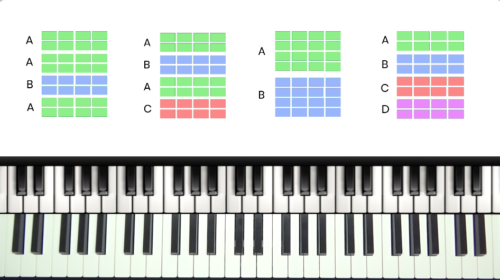“Autumn Leaves” – C Section
Welcome to the final lesson in our beginner exploration of the tune “Autumn Leaves”. Having previously explored both the A and B sections of this classic jazz standard, we now turn our focus to the final 8-bar section of the song: the C section.
In this lesson you will learn the harmony and melody of the C section and then we will play through the song in its entirety to consolidate all of the lessons in this module.
C Section Melody
The C-section is the final 8 bars of the tune. This 8-bar section introduces a new melody which which clearly differentiates it from the A and B Sections. We begin by isolating the melody in our right hand and we pay attention to the the chromatic melody used to transition between the B and C sections.
C Section Harmony & Voicings
Next we isolate the harmony so that we can clearly visualise the chord progressions, voicing configurations, and the voice leading of 7ths falling to 3rds. Emphasis is placed on voicing configurations that create an even spread across both hands to create a balanced sound in our chord voicings.
Practice Tips
-
Isolate common progressions: Begin by practicing the C-section’s unique harmonies in isolation before playing them in context of the tune.
-
Voicing configurations: Experiment with different voicing configurations to find the most balanced way to spread the notes across both hands.
-
Performance time: Once comfortable with the C section, you're ready to combine all of the sections as demonstrated towards the end of this lesson.
-
Visualise the form: Develop a mental map of the song’s structure AABC. Dividing it into these manageable sections aids in memorisation and performance.





Melody embellishments coming up?
Hi Humberto,
Yes I will add another lesson to this course on melodic embellishment, and also more “Novice” courses in different keys.
We do have a tutorial on Autumn Leaves here which covers melodic embellishments: https://www.pianogroove.com/jazz-piano-lessons/autumn-leaves-tutorial/
This lesson incorporates more advanced harmony and also scale runs and other melodic patterns that can be used when playing this tune as a ballad. Please check out that lesson in the interim.
Talk soon,
Hayden
Hi, Hayden, thanks for your reply. I had already seen and gone through the other Autumn Leaves lesson you referenced with the more advanced harmony and melodic embellisments but wanted to see what you would include in this novice course. Although I am past the novice level I have found the novice courses to be extremely useful because they put together many important elements of jazz piano learning in one neat package. They are a great way to review what I have learned in other lessons and also a great refresher for remembering songs I may not have played for a while. Lookng forward to more of these courses in the future and I recommend them highly to those just starting out.
My pleasure, Humberto.
Yes I imagined you had already found the other lesson on “Autumn Leaves” as I recorded that many years ago.
My plan with this course is to demonstrate some simpler melodic embellishment ideas. I’d like to add a lesson to each jazz standard in the Novice section where we listen to a selection of recordings and I explain how to pick thing from the recordings, such as little melodic embellishments and ways to rephrase the melody etc…
I think that would work better than me simply showing a bunch of possible embellishments, because it would help students to see how fun and rewarding it can be to transcribe and emulate recordings, once that we have a basic arrangement in place.
That’s wonderful to hear.
On the website and in the community area, I recommend that new students set a goal to learn 10 to 20 tunes, but I realised that many of the jazz standard tutorials – even the ‘beginner’ ones – contain reharmonisations, substitutions, and other more complex theory which can be a little intimidating for new jazz piano students.
So the plan is that this new Novice section will have 20 jazz standards that are simple, easy to learn, but at the same time very beautiful to play. That way we have a wide range of tunes in this section that help students to build out their repertoire as quickly as possible – which is the goal when starting out with jazz.
It’s funny because sometimes ‘coming back to the basics’ is exactly what we need. It helps us to build stronger foundations which allows us to develop in other more advanced areas. I myself found it very useful to revisit some of these tunes with basic R-3-7 voicings, particularly “My Foolish Heart” which I hadn’t played often.
Once we have memorised a basic arrangement of a tune, we then have more freedom to move in other directions when playing it. As oppose to learning a very sophisticated arrangement by heart – which can sometimes be challenging to remember all of the intricate pieces.
More new Novice lessons to follow this month!
Talk soon,
Hayden
Hayden, that is great to hear.